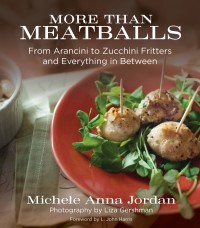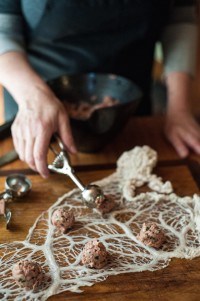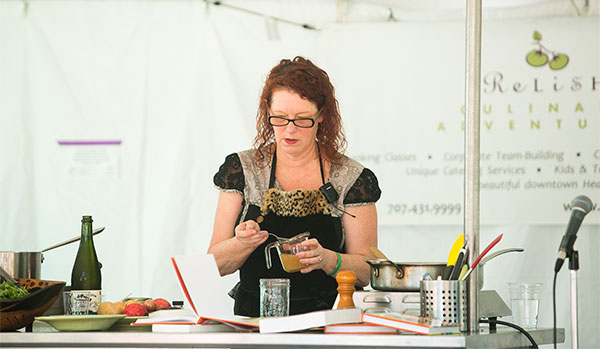 “Why did you write a book about meatballs?” a man asked at last weekend’s Extra Virgin Festival at B. R. Cohn Winery, where I was featuring the new edition of “The Good Cook’s Book of Oil & Vinegar.”
“Why did you write a book about meatballs?” a man asked at last weekend’s Extra Virgin Festival at B. R. Cohn Winery, where I was featuring the new edition of “The Good Cook’s Book of Oil & Vinegar.”
Pausing before I answered, I wondered if the honest answer was the way to go. Why not?
“Because I wanted to feminize meatballs,” I confessed, adding that books about meatballs tend to feature large globes of dry meat in gloppy sauces. I thought there was room and perhaps even a need for more elegant, nuanced, and, yes, feminine meatballs.
I was right.
“More Than Meatballs” was released in late 2014 and now there is a new edition, a paperback with 10 additional recipes, released last month by Skyhorse Publishing.
I don’t care much for meatballs that call for turkey instead of the meat that is traditionally used, a trend in America because of a misperception that turkey is healthier than other meats. But turkey meatballs should celebrate turkey for its own qualities, which means that they should taste like thanksgiving dinner, which these do.
— Michele Anna Jordan
Turkey Meatballs with Fresh Sage and Cranberry Salsa
Makes about 24 small meatballs
4 tablespoons tablespoons butter
1 small yellow onion, cut into very small dice
2 celery stalks, cut into very small dice
1/4 cup minced fresh sage leaves
Kosher salt
Black pepper in a mill
2 cups, very lightly packed, hand-torn sourdough bread, without crusts
Small sage sprig
1/2 cup whole milk or half-and-half
1 1/2 pounds freshly ground turkey thigh
1 egg, beaten
6 ounces caul fat (see Note below)
1 tablespoon olive oil or clarified butter
 Melt the butter in a heavy skillet set over medium heat; add the onion and celery, reduce the heat to low and sauté gently until very soft and fragrant, about 15 minutes. Stir in the sage leaves and season generously with salt and pepper.
Melt the butter in a heavy skillet set over medium heat; add the onion and celery, reduce the heat to low and sauté gently until very soft and fragrant, about 15 minutes. Stir in the sage leaves and season generously with salt and pepper.
Put the bread, sage sprig, and milk in a small saucepan set over very low heat. When it is heated through and the milk fully absorbed by the bread, use a fork to mash the bread, reducing it as much as possible to a sort of slurry. Season with salt and pepper, remove from the heat and set aside.
When the onion mixture and the bread mixture have cooled to room temperature, add them to the turkey and mix thoroughly. Add the egg and mix again.
Cover and refrigerate for at least an hour and as long as overnight.
To finish the meatballs, cover a baking sheet with a sheet of wax paper.
Spread the caul fat over a clean work surface and wrap each ball, overlapping the edges and setting each wrapped ball on the wax paper, seam side down.
To cook, set a large heavy sauté pan over medium heat and when it is hot add several meatballs. Cook for 45 seconds and then agitate the pan so that the balls roll. Continue to cook until evenly browned and beginning to firm up.
To finish, return all the balls to the pan, reduce the heat to very low, cover and cook gently until just done, about 7 minutes more.
Note: Caul fat is a thin lace-like membrane that encases the inner organs of certain animals. It is available at Sonoma Meat Company (35 Sebastopol Rd., Santa Rosa) and at other butcher shops. It is quite inexpensive and easy to use.
Serving Suggestions: As an appetizer, with cranberry relish or cranberry salsa; in turkey soup; on sandwiches with cream cheese and cranberry sauce.
Michele Anna Jordan, an award-winning writer and chef, recently launched micheleannajordan.com, a comprehensive website that gathers together her passion for writing, home cooking and Sonoma County and augments her work for The Press Democrat, her radio show Mouthful, in its 21st year on KRCB-FM and a four-time James Beard nominee, and her books, more than 24 to date. Jordan grew up in the North Bay and raised her children on a dairy farm in Lakeville, east of Petaluma. Among her many awards are a James Beard Award for Magazine Feature Writing and Best Chef Sonoma County.




Be First to Comment